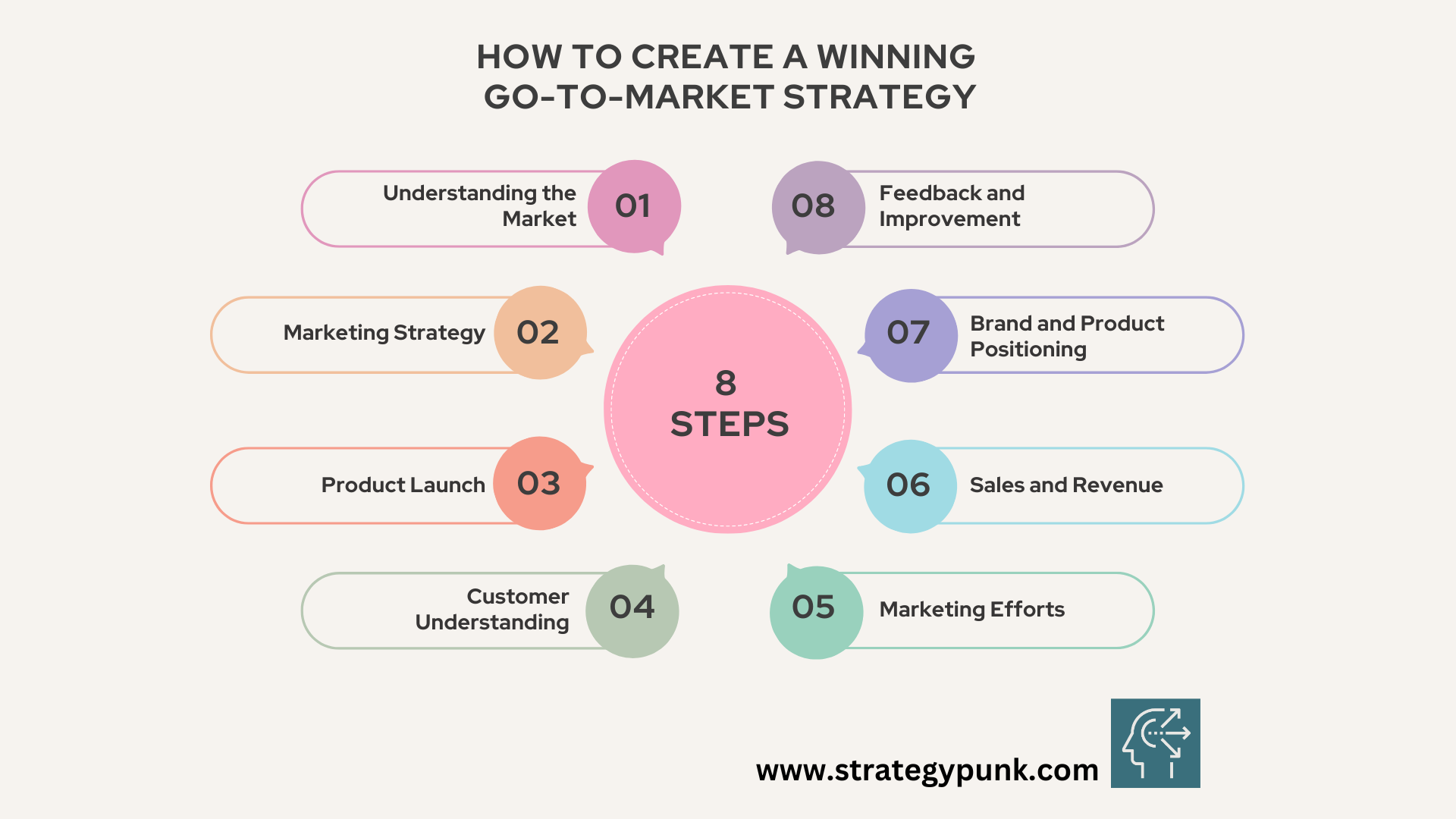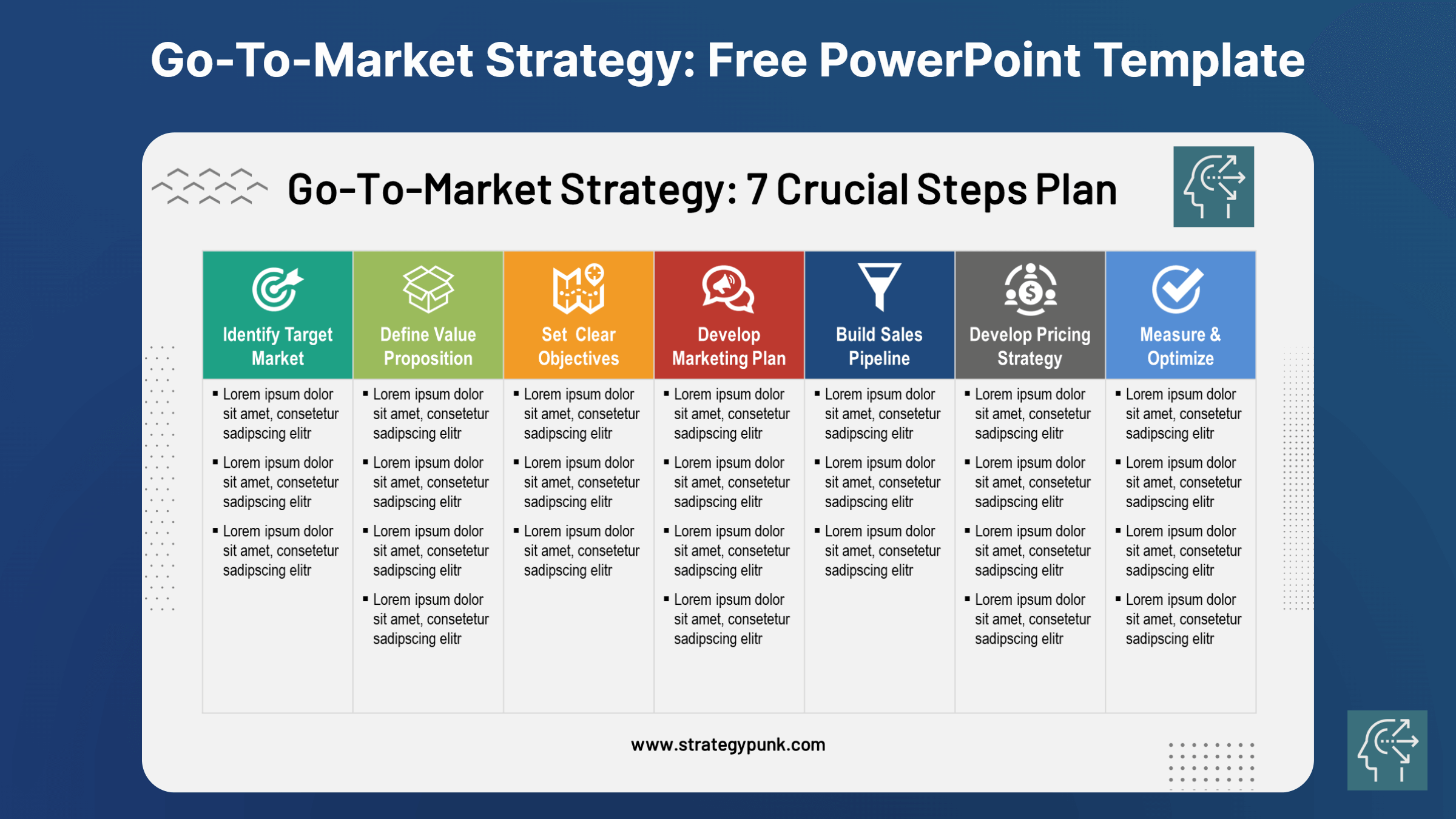How to Create a Winning Go-to-Market Strategy (Free Template)
Boost your product launches with a comprehensive go-to-market strategy. Uncover your target market's needs and launch effectively. Get our free template.

Introduction
Are you looking to launch a new product or service? If so, you'll need a go-to-market strategy. This plan outlines how you'll introduce your offering to the market, generate demand, and ultimately drive sales. With a solid system in place, your launch could stay flat.
You must understand your target market to create a successful go-to-market strategy. Who are your ideal customers? What are their pain points? What motivates them to make a purchase? Once you've identified these critical insights, you can develop a marketing strategy that speaks directly to their needs and desires.
Your product launch will be a key component of your go-to-market strategy. This is your opportunity to make a big splash and generate excitement around your offering. But more is needed to unveil your product or service. You'll need to create a comprehensive launch plan that includes everything from social media teasers to press releases to influencer partnerships. By taking a strategic approach to your launch, you can ensure your product gets the attention it deserves.
Key Takeaways
- A go-to-market strategy is essential for successfully launching a new product or service.
- Understanding your target market is crucial to developing an effective marketing strategy.
- A well-planned product launch can help generate excitement and drive sales.
Understanding the Market
To create a successful go-to-market strategy, you must first understand your market. This involves conducting thorough market research, analyzing your competitors, and identifying your target audience.
Market Research
Market research gathers information about your market, including its size, growth potential, and trends. It is essential to conduct market research regularly to stay current with market changes.
Market research can be conducted using various methods, including surveys, focus groups, and online research. You should also analyze industry reports and data to better understand the market.
Competitor Analysis
Competitor analysis involves:
- Identifying your competitors.
- Analyzing their strengths and weaknesses.
- Determining how to differentiate yourself in the market.
You can develop a strategy to gain a competitive advantage by understanding your competitors.
You can use tools such as SWOT analysis, Porter's Five Forces, and market share analysis to conduct a competitor analysis. It would help to analyze your competitors' marketing strategies, pricing, and product offerings.
Target Audience
Identifying your target audience is crucial to creating a successful go-to-market strategy. Your target audience is the group of people who are most likely to buy your product or service.
Analyzing demographics, buyer personas, and market trends to identify your target audience would be best. This will help you develop a deep understanding of your audience's needs, preferences, and behaviors.
By understanding your market, conducting thorough research, and analyzing your competition, you can create a go-to-market strategy that effectively targets your audience and differentiates you in the marketplace.
Marketing Strategy
To successfully launch your product or service, you need a go-to-market strategy that includes a solid marketing plan. Here are some key sub-sections to consider when developing your marketing strategy:
Setting Goals
Before planning your marketing activities, you need to set clear and measurable goals. This will help you stay focused and ensure your efforts align with your business objectives. Your goals should be specific, measurable, achievable, relevant, and time-bound (SMART). Marketing goals include increasing brand awareness, generating leads, driving website traffic, and boosting sales.
Budget Planning
Once you have set your marketing goals, you must determine the required budget. Your budget should align with your business objectives, and your marketing activities' short-term and long-term impact should be considered. It would help if you also considered the cost of different marketing channels and tactics, such as social media advertising, email marketing, content marketing, and events.
Aligning with Business Objectives
Your marketing strategy should be closely aligned with your business objectives. This means understanding your target audience's needs and preferences and developing messaging and positioning that resonates with them. You should also consider the competitive landscape and how to differentiate your product or service.
By setting clear goals, planning your budget, and aligning your marketing strategy with your business objectives, you can develop a marketing plan that drives results and helps you achieve your goals.
Product Launch
Go-To-Market Strategy
Before launching your product, you must have a well-defined go-to-market strategy. This plan will help you identify the target audience, create a marketing plan, and set sales goals. Your strategy should outline how you will build brand awareness, generate leads, and convert them into customers. It should also include how you will measure the success of your launch.
Launch Strategies
There are several strategies for launching your product. One popular approach is the "big bang" launch, where you simultaneously release your product to the market. Another option is a soft launch, where you release your product to a select group of customers to gather feedback before launching to a broader audience. Whichever strategy you choose, make sure you plan to create buzz and excitement around your product.
Post-Launch Support
After your product launch, it's essential to provide support to your customers. This support can include customer service, troubleshooting, and ongoing product updates. Providing excellent post-launch support will help you retain customers and build a loyal customer base.
To ensure a successful product launch, ensure a well-defined go-to-market strategy, choose the right launch strategy, and provide excellent post-launch support. By doing so, you can increase your chances of creating a successful product that meets the needs of your target audience and generates revenue for your business.
Customer Understanding
You need to understand your customers deeply to create a successful go-to-market strategy. This involves identifying their needs, understanding their behavior, and mapping their journey. Here are the sub-sections that will help you gain a better understanding of your customers:
Identifying Customer Needs
To identify your customer's needs, you need to ask yourself a few questions:
- What problem are they trying to solve?
- What are their pain points?
- What are their goals and aspirations?
- What are their values and beliefs?
Once you have the answers to these questions, you can develop a product or service that meets their needs.
Buyer Personas
Buyer personas are fictional representations of your ideal customers. They help you understand your customers' behavior, motivations, and goals. To create a buyer persona, you must gather information about your customers, such as their age, gender, income, education, and job title. You can also use surveys, interviews, and focus groups to gather more information.
Customer Journey Mapping
Customer journey mapping visualizes your customer's journey from the first point of contact to the final purchase. This helps you understand your customers' different touchpoints and interactions with your brand. To create a customer journey map, you need to:
- Identify the various stages of the customer journey
- Map out the touchpoints and interactions
- Identify the pain points and areas for improvement
Understanding your customer's journey can create a better customer experience and improve your product or service.
In conclusion, understanding your customers is vital to creating a successful go-to-market strategy. By identifying their needs, creating buyer personas, and mapping out their journey, you can develop a product or service that meets their needs and provides a great customer experience.
Marketing Efforts
Creating a successful go-to-market strategy requires a solid marketing plan that outlines your marketing efforts. This section will cover the three main marketing sub-sections: channel selection, advertising and promotion, and social media marketing.
Channel Selection
Choosing the proper marketing channels is crucial for the success of your go-to-market strategy. Please identify the most effective channels to reach your target audience. Some of the most common marketing channels include:
- Email marketing
- Direct mail
- Search engine marketing
- Social media marketing
- Influencer marketing
- Content marketing
- Events and trade shows
Each channel has advantages and disadvantages, so it's essential to evaluate them carefully and choose the ones that align with your marketing goals.
Advertising and Promotion
Advertising and promotion are essential components of your marketing efforts. You'll need to create a compelling message that resonates with your target audience and choose the best advertising and promotion channels to reach them. Some of the most common advertising and promotion channels include:
- TV and radio ads
- Print ads
- Online ads (e.g., Google AdWords)
- Social media ads
- Influencer marketing
- Public relations
Your advertising and promotion strategy should be aligned with your overall marketing goals and target audience.
Social Media Marketing
Social media marketing is an essential component of your marketing efforts. It allows you to engage with your target audience, build brand awareness, and drive traffic to your website. Some of the most popular social media platforms for marketing include:
- YouTube
Your social media marketing strategy should include organic and paid content and engagement with your followers.
In conclusion, your marketing efforts are critical to the success of your go-to-market strategy. By carefully selecting your marketing channels, creating a compelling message, and leveraging social media, you can effectively reach your target audience and achieve your marketing goals.
Sales and Revenue
It would be best to focus on generating sales and revenue to create a successful go-to-market strategy. This section will cover some essential factors to consider in order to achieve this.
Pricing Strategy
Your pricing strategy is crucial to your sales and revenue. It would help if you found the right balance between affordability and profitability. Consider the following when developing your pricing strategy:
- Research your competitors' pricing strategies to make sure you are competitive.
- Understand your target market's willingness to pay.
- Consider the cost of goods sold (COGS) and other expenses when setting your prices.
- Test your pricing strategy to find the optimal price point.
Sales Cycle Understanding
Understanding your sales cycle is essential to your sales and revenue. You need to know how long it takes to close a deal, what factors influence the sales cycle, and how to improve it. Consider the following when analyzing your sales cycle:
- Identify the stages of your sales cycle.
- Measure the length of your sales cycle and identify any bottlenecks.
- Understand the key decision-makers and their decision-making process.
- Develop strategies to shorten your sales cycle.
Return on Investment
Your return on investment (ROI) is a critical metric to measure the effectiveness of your sales and revenue strategies. You need to understand how much revenue you generate for each dollar you invest in sales and marketing. Consider the following when analyzing your ROI:
- Calculate your ROI for each sales and marketing campaign.
- Identify the most effective campaigns and invest more in them.
- Understand the factors influencing your ROI, such as customer acquisition cost (CAC) and lifetime value (CLV).
- Continuously monitor and improve your ROI.
You can increase your sales and revenue by focusing on your pricing strategy, sales cycle understanding, and ROI.
Brand and Product Positioning
Brand and product positioning are crucial factors when creating a go-to-market strategy. This section will explore the critical components of brand and product positioning, including value proposition, brand awareness, and competitive advantage.
Value Proposition
Your value proposition is the unique benefit that your product or service provides to your target customers. It should communicate what sets your offering apart from your competitors and why customers should choose your product over others. To create a compelling value proposition, consider the following:
- Identify your target customer: Who is your ideal customer? What are their pain points and needs?
- Determine your unique selling proposition: What differentiates your product from your competitors? What are the key benefits that your product offers?
- Communicate your value proposition: Craft a clear and concise statement communicating your product's value to your target customers.
Brand Awareness
Brand awareness refers to the extent to which your target customers are familiar with your brand. Building brand awareness to establish credibility and trust with your customers is crucial. To build brand awareness, consider the following:
- Develop a strong brand identity: Create a recognizable logo, color scheme, and tone of voice that aligns with your brand values.
- Leverage social media: Use social media platforms to showcase your brand and engage with your target customers.
- Partner with influencers: Collaborate with influencers in your industry to reach a wider audience and build brand awareness.
Competitive Advantage
Your competitive advantage is what sets your product apart from your competitors. Communicating your competitive edge to your target customers is essential to establish your product's superiority. To identify your competitive advantage, consider the following:
- Conduct a competitive analysis: Identify your main competitors and their strengths and weaknesses.
- Determine your unique selling proposition: What differentiates your product from your competitors?
- Communicate your competitive advantage: Communicate your unique selling proposition to your target customers through marketing materials.
Remember, brand and product positioning is crucial to the success of your go-to-market strategy. You can establish your product's superiority in the market by clearly communicating your value proposition, building brand awareness, and identifying your competitive advantage.
Feedback and Improvement
As you implement your go-to-market strategy, it's crucial to continuously gather feedback and track performance metrics to identify areas for improvement. This will help you refine your strategy and ensure you meet your goals.
Customer Feedback
One of the most valuable sources of feedback is your customers. Gathering customer feedback can help you gain insights into what's working well and what needs improvement. You can collect this information from surveys, focus groups, or customer feedback forms.
When analyzing customer feedback, it is essential to look for patterns and trends. Are there particular issues that come up repeatedly? Are there specific areas where customers are particularly satisfied or dissatisfied? By identifying these patterns, you can prioritize areas for improvement and make targeted changes to your strategy.
Performance Metrics
In addition to gathering customer feedback, it's essential to track performance metrics to measure the success of your go-to-market strategy. Key performance indicators (KPIs) such as conversion rate, customer acquisition cost, and customer lifetime value can help you understand how your system is performing.
When analyzing performance metrics, it is essential to look at trends over time and compare your performance to industry benchmarks. This will help you identify areas where you're underperforming and make targeted changes to improve your results.
Continuous Improvement
Finally, it's important to remember that your go-to-market strategy should be an ongoing continuous improvement process. By gathering feedback and tracking performance metrics, you can identify areas for improvement and make targeted changes to your strategy.
Tracking the impact of those changes on your performance metrics is essential as you make changes. This will help you understand if your modifications have the desired effect and make any other necessary adjustments.
Gathering feedback and tracking performance metrics are critical components of a successful go-to-market strategy. By continuously improving your system using these tools, you can ensure that you're meeting your goals and delivering value to your customers.
How to Create a Winning Go-to-Market Strategy PDF Template
Download our free Go-to-Market Strategy Template, a step-by-step guide designed to help you understand your target market, strategize your product launch, and captivate your audience.
Empower your business to make a lasting impact with each new product or service release.
Clickworthy Resources
Mastering Your Go-To-Market Strategy: 7 Crucial Steps for Success (Plus Free PPT Template)
Discover the critical steps to creating a successful go-to-market strategy plan. Follow our guide and achieve growth with our proven steps. Download our free PowerPoint template to get started today!

Mastering 5 Key Go-to-Market Strategies for Exceptional Business Growth
Unlock rapid growth with five powerful strategies! Click to reveal the secrets successful businesses don't want you to know, and download our free PDF template.







